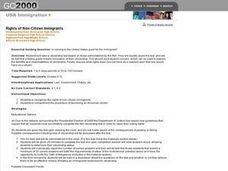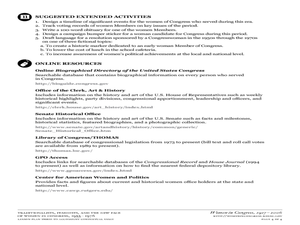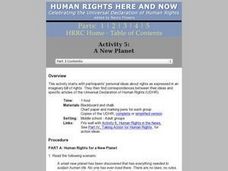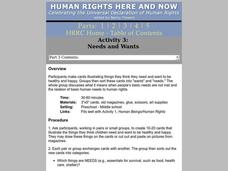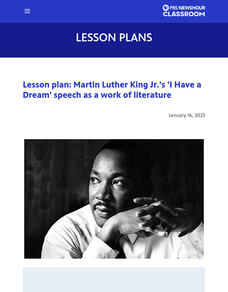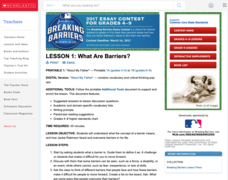Curated OER
A World Made New: Human Rights After the Holocaust
Students examine the development of the Universal Declaration of Human Rights. After reading excerpts, they discover how cultural values have been blended into the UDHR. They discuss how their school and community deal with human rights...
Curated OER
Religious Freedom - Universal Declaration of Human Rights
Learners examine the issue of religious freedom in the Universal Declaration of Human Rights. They annotate on maps places where religious persecution has occured. Students in pair participate in an active listening exercise as each one...
Curated OER
Rights of Non-Citizen Immigrants
Students continue their discussion of if coming to America was the best thing for a group of immigrants. As a class, they complete the citizenship test offered by the INS. They research the benefits and responsibilities of being a...
Curated OER
Individual Rights And Responsibilities
Students investigate a trial in the netherlands in order to comprehend the concept of human rights and how they need protection. They conduct the research done by reading in small groups and have a mock trial using the details of the...
Curated OER
Discrimination
Students investigate what discrimination is and study Article 2 from the Universal Declaration of Human Rights. They participate in a role play activity involving majority and minority groups for which a letter was sent home to parents....
Curated OER
A Changing of the Guard: Traditionalists, Feminists, and the New Face of Women in Congress
Students explore the role of women as Congressional leaders. In this women's rights lesson, students identify and investigate the impact of women representatives and senators in the U.S. Legislative Branch. Comprehension questions, data,...
Curated OER
Dubois and Washington Venn Diagram
Students compare and contrast the visions of W.E.B. Dubois and Booker T. Washington. In this African American history lesson, students read biographies about both men and create a Venn diagram about the men.
Curated OER
A New Planet
Students, in gorups, develop a Bill of rRghts for a newly discovered planet. They give the planet a name and they decide upon ten human rights they think are the most important. Then they compare their list with the lists of other...
Curated OER
Needs And Wants
Students make cards illustrating things they think they need and want to be healthy and happy. Groups then sort these cards into "wants" and "needs." The whole class discusses what it means when people's basic needs are not met and the...
Curated OER
The Underground Railroad
Students examine slavery and the civil war by creating a research project. In this underground railroad lesson, students create a KWL chart and decide on one of several creative projects they will complete about slavery. Students...
Teaching Tolerance
Racial Disparity in the Criminal Justice System
Explore the impact of the war on drugs in a thought-provoking lesson plan for high school academics. Young historians delve into the world of the criminal justice system and the racial disparity that occurs in the US. The resource...
Albert Shanker Institute
Dream Under Development
As part of their study of the 1963 March on Washington, class members do a side-by-side comparison of the original text of Martin Luther King's "I Have a Dream Speech" with a transcript of the speech he delivered. The take away from the...
Facing History and Ourselves
The Legacies of Reconstruction
The final instructional activity in the seven-resource Reconstruction Era collection examines the legacies of Reconstruction. Class members investigate why the period has been called an "unfinished revolution," "a splendid failure," and...
US House of Representatives
Keeping the Faith: African Americans Return to Congress, 1929–1970
The third lesson in a unit that traces the history of African Americans serving in the US Congress examines the period from 1929 through 1970. After reading a contextual essay that details the few African Americans elected to Congress...
Scholastic
Connecting with Ruby Bridges
When Ruby Bridges entered an all-white school in New Orleans in 1960, she also entered history. Scholars consider what the experience must have been like for the young girl using two books that document her experience as well as a double...
American Institute of Physics
African American Physicists in the 1960s
Physicists Herman Branson and Tannie Stovall provide young scholars with two very different perceptions of the status of African American physicists in the 1960s. After reading and comparing the bios of these two men, class members read...
PBS
Dr. Martin Luther King Jr.’s ‘I Have a Dream’ Speech as a Work of Literature
To appreciate the oratory of Dr. Martin Luther King Jr.'s "I Have a Dream" speech, scholars examine the rhetorical devices and influences that make the speech so famous. They examine background information, conduct a close reading of the...
US House of Representatives
“The Fifteenth Amendment in Flesh and Blood,” The Symbolic Generation of Black Americans in Congress, 1870–1887
The reading of a contextual essay launches a study of Black Americans who served in Congress from 1870 through 1887. Young historians identify the African Americans who served during this period, investigate the ways they won national...
Facing History and Ourselves
A Contested History
Memories of and interpretations of history change—that's the key takeaway from a lesson that has young historians compare the story of the Reconstruction Era as told by the historians of the Dunning School to the view of scholars today...
Historical Thinking Matters
Rosa Parks: 5 Day Lesson
What led to the success of the Montgomery Bus Boycott, and how might historians approach this question differently? This rich series of lessons includes a short introductory video clip, analysis of six primary source documents, and...
Scholastic
Jackie Robinson
Learners complete a six-page coloring book featuring Major League Baseball's first African American player, Jackie Robinson. To bring the pages to life, scholars follow directions adding color and pictures where directed.
Scholastic
Lesson 1: What Are Barriers?
Scholars discuss the concept of a barrier with a short passage on Jackie Robinson. The writing process begins with a paragraph and several other sentences about Robinson's unique traits that made breaking a barrier possible.
US House of Representatives
Permanent Interests: The Expansion, Organization, and Rising Influence of African Americans in Congress, 1971–2007
The fourth installment of the seven-instructional activity unit focused on African Americans elected to and serving in the US Congress looks at the period from 1971 through 2007. Class members read a contextual essay that provides...
Center for History Education
Freedom for All? The Contradictions of Slavery and Freedom in the Maryland Constitution
Freedom for the few! An interesting lesson focuses on the Maryland Constitution and its lack of freedom for African Americans. Scholars examine the premise of freedom for all—which only extended to a limited few. Academics complete...




